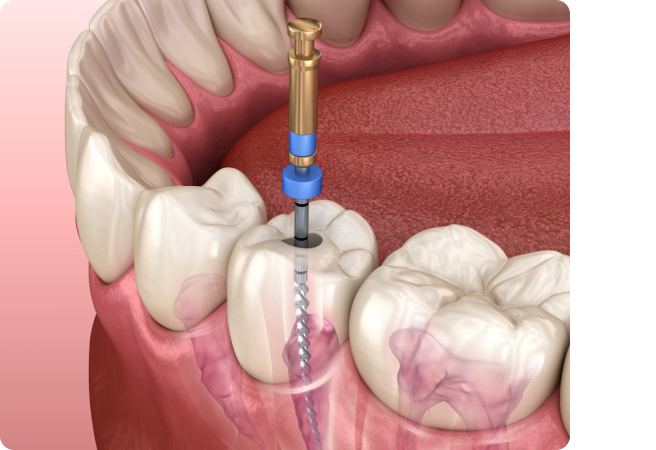Choosing the Best Replacement for Missing Teeth: A Practical Guide
What is the best option for replacing missing teeth?...
A root canal is the removal of an infected nerve, which the Gentle Dental Centre undertakes with our usual gentle approach.
Root canal treatment works to remove infection from the centre of the tooth. Before treatment, you’ll be given local anesthetic to make sure you don’t feel anything. Our gentle dentists will remove the bacteria, fill the root canal and seal the tooth with a filling or a crown. Your dentist will tell you what to do after a root canal. It’s important that you follow their instructions so that you don’t agitate your tooth while it heals.
Root canals have a reputation for being a painful dental procedure. You may experience some discomfort and tenderness after the treatment. However, root canal procedures aren’t any more painful than other types of dental work such as getting a filling.
In years gone by, teeth damaged by bacteria were simply removed. Today, removing teeth is not recommended. Natural teeth provide structure to the mouth and jaw, provide support to the teeth next to them and make chewing and eating easier. For these reasons, at Gentle Dental we always try to restore a patient’s natural teeth whenever we can.
The good news is it’s possible to prevent the need for a root canal in the first place. Establishing a regular oral hygiene routine will help keep your teeth clean and free from bacteria. Brushing twice a day, flossing daily, and regular dental checkups are the best ways to take care of your teeth and gums. If you think you need a root canal or need dental care in Wellington, book an appointment with the team at Gentle Dental.


Often there will be signs and symptoms. These may include:
Determining whether or not you need a root canal procedure based on symptoms alone can be difficult. The most common symptom is tooth ache. The inner pulp of your teeth is extremely sensitive. However, just because you are experiencing tooth pain doesn’t mean you’ll need a root canal procedure or that your tooth pulp is infected. Other characteristics of tooth pain may indicate a root canal infection.
If you are experiencing severe pain while chewing, pain that stops you from sleeping, pain that occurs when you put pressure on the top of the infected tooth, thermal stimuli pain from hot or cold liquids, pulsating, lingering or spontaneous pain, you may have an infection in the pulp of your tooth. Bad breath is also a sign of infection — especially if your oral health is usually good.
Gum tenderness and swelling are common symptoms associated with a root canal infection. Although the infection is within the soft pulp at the centre of your tooth, it’s common to feel swelling in the gums. If you see a pimple-like boil appear in front of the root tip or pronounced swelling, you should see your dentist immediately.
Infections don’t just happen on their own. As the pulp of our teeth are enclosed by the tooth enamel, damage needs to occur first before bacteria can get in. Cracked teeth, broken fillings or trauma to a tooth can cause damage to the enamel which then opens the door for infection.
If any of these symptoms sound familiar you may need root canal treatment. Book an appointment with Gentle Dental immediately.





In the simplest terms, a root canal procedure is performed to remove bacteria and infection from the pulp of your tooth. Beneath the layer of enamel on the outside of our teeth is a hard layer called the dentin and a soft tissue called the pulp. The pulp contains the nerves, connective tissue and blood vessels that keep our teeth alive.
The pulp extends from the centre of each tooth all the way towards the roots. In our early years, the pulp is important because it helps our teeth to grow. However, as adults our teeth have fully matured and our teeth can actually survive without the pulp. That’s why rather than just extracting infected teeth, dentists instead work to remove the infection and save the tooth.
During the root canal procedure, your dentist will work to remove all of the infected pulp, clean and shape the inside of the root canal, and then fill and seal the tooth. To remove the infection the dentist needs to drill down into the tooth. Therefore, once the root canal treatment is completed a filling or sealant needs to be placed on top of the tooth to prevent bacteria from getting in again. Two separate procedures are required, but this doesn’t increase the cost of root canal treatment.
The short answer to this is ‘no’.
At the Gentle Dental Centre, root canal therapy will cause no more discomfort than a normal dental filling procedure, both of which are performed under local anaesthetic to minimise any sensation of pain.
In fact, most of our patients say that they hardly felt anything at all!
Learn more about dental restoration and how to care for your teeth from our latest blog posts.
What is the best option for replacing missing teeth?...
Two popular options for creating a lovely smile are a...
Here are some tips for post-surgery care and long-term...
A common misconception about dental fillings is that...
Root canals might seem scary, but the procedure is...
If you’ve ever had tooth decay, your dentist may...
Imagine if rather than getting a filling to fix tooth...
If you have tooth decay, your dentist may ask you...
Wisdom tooth extraction is a surgery that removes one or...
Most people will recover from root canal treatment in a few days. It is normal to experience discomfort in the days following a root canal procedure. There are a few things you can do to reduce the pain. Your dentist will also tell you what to do after a root canal to help you heal. Firstly, try and chew with the other side of your jaw to keep food away from your tooth. This is especially important after your first appointment as your tooth will not yet be fully sealed. You can take over-the-counter pain medication to reduce the pain. Brush with a soft bristled brush twice a day very gently and avoid hard or sticky foods until you are fully healed.
You do need a crown after a root canal procedure. This is because your dentist needs to drill into your tooth to remove the infection and without a crown the insides of your tooth will remain exposed and susceptible to bacterial infection. A crown also helps to provide strength and structure to your tooth. After root canal treatment the inside of your tooth is hollowed out which also weakens the integrity of your tooth. A crown helps to give your tooth back some of its structure. The price of a crown should be included in the root canal cost. The price of a root canal can differ slightly depending on which tooth is infected.
Root canal treatments are completed in two procedures to give your tooth a chance to heal between appointments. After your dentist has cleaned and removed the infection from inside the tooth and placed a temporary seal on it, they will then schedule a second appointment to place a crown on your tooth. There is usually an interval of one to two weeks between each visit. After one week your tooth should have healed and you should no longer be experiencing discomfort or pain from your root canal procedure. The price of both root canal appointments will be discussed at the initial consultation.
